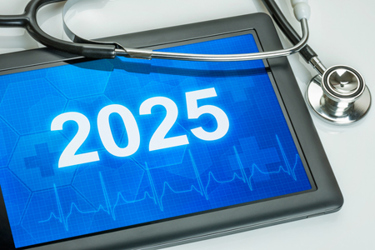What's Trending In Medical Devices And Diagnostics For 2025?
A conversation with experts from the Medical Device Innovation Consortium (MDIC)

As the medical device and diagnostics landscape continues to evolve, 2025 is shaping up to be a year defined by collaboration, inclusivity, and technological advancement. Drawing from their extensive expertise, four program directors from the Medical Device Innovation Consortium (MDIC) share their predictions on the trends that will drive innovation and reshape clinical research. From improving patient input to enhancing regulatory processes, these insights offer a roadmap for a patient-centered future in healthcare.
The Science Of Patient Input: A New Era Of Inclusivity And Transparency
There is growing momentum to integrate patient perspectives into medical product R&D and regulatory decision-making processes, driven by a commitment to greater inclusivity and data transparency. According to Kert Gunasekaran, MDIC’s program director for the science of patient input, initiatives like the FDA’s Device Trial Snapshots are already setting the stage for broader representation in clinical trials. These programs not only provide crucial details about trial demographics but also empower patients with transparent information about device risks and benefits.
“Ensuring inclusivity in trials allows medical research to better serve all population segments,” explains Gunasekaran, emphasizing the importance of addressing the underrepresentation of women, minorities, and the elderly. Industry, government, and patient advocacy groups are joining forces to reduce these disparities, aiming for a healthcare system that truly reflects the needs of all patients.
Transparency also plays a pivotal role, with open data practices enhancing trust, accuracy, and reproducibility. Citing the success of mRNA vaccine trials, Gunasekaran highlights how collaborative data sharing can accelerate breakthroughs. As MDIC continues to support these efforts, inclusivity, and transparency will serve as cornerstones for a patient-centric healthcare ecosystem.
Clinical Diagnostics: Advancing Decentralized Trials
Decentralized and hybrid clinical trials are no longer a future goal — they’re becoming the norm. Maryellen de Mars, Ph.D., MDIC’s program director for clinical diagnostics, predicts that advancements in analytical validation tools will solidify this shift in 2025.
“These tools are critical for maintaining data integrity across diverse sources,” says de Mars, pointing to the growing reliance on local labs, wearables, and mobile apps. The ability to uphold rigorous standards for accuracy and reproducibility is particularly crucial for complex trials, such as those involving biomarker-based cancer therapies.
With these advancements, the promise of decentralized trials becomes more tangible, enabling researchers to bring scientifically robust, patient-centered models to life. As de Mars emphasizes, MDIC views these innovations as integral to the future of clinical research.
IVD Data Standards: Streamlining The Path To Market
2025 may mark a turning point in regulatory efficiency for in vitro diagnostics (IVD). The introduction of standardized data practices is expected to not only shorten review times but also enhance transparency for both regulators and manufacturers.
“These standards have the potential to reduce review times, ensuring patients and healthcare providers gain faster access to innovative diagnostics,” says Pipper White, MDIC’s senior program manager for clinical diagnostics. While adapting to these standards may pose initial challenges for manufacturers, the long-term rewards — ranging from improved product quality to expanded market access — are undeniable.
White underscores MDIC’s commitment to advancing data quality and regulatory efficiency, positioning these changes as transformative for the industry. By streamlining the clinical trial process, IVD manufacturers will be better equipped to navigate the complexities of bringing new products to market.
Early Feasibility Studies: Pioneering Medical Innovation
The U.S. Early Feasibility Study (EFS) program has been instrumental in facilitating the early evaluation of medical devices. Since its inception, EFS has supported approximately 60 submissions annually and engaged over 4,000 participants across various fields. The program is expected to continue growing in 2025 as it adapts to evolving industry needs and priorities.
However, challenges remain. “Effective site and clinician selection are key to overcoming hurdles like staff turnover and patient recruitment,” explains Eileen Mihas, MDIC’s program director for early feasibility studies. Leveraging models such as clinician/site unification and site-driven external support can help mitigate these issues, ensuring EFS maintains its global relevance.
The program is also aiming to expand beyond its current focus on structural heart projects, tackling preclinical challenges such as biocompatibility and animal testing. Mihas notes, “Future efforts will focus on adapting to post-pandemic staffing realities, optimizing coordination with international studies, and refining regulatory frameworks to reduce preclinical burdens.” These efforts build upon a decade of insights into site and regulatory dynamics, positioning EFS to remain a cornerstone for early-stage medical device innovation.
Looking Ahead: Driving Progress Through Collaboration and Innovation
2025 presents an opportunity for the medical device and diagnostics field to address longstanding challenges while embracing innovation. Whether through greater inclusivity in clinical trials, advancements in decentralized trial tools or streamlined regulatory processes, the year ahead is set to redefine patient-focused care.
These insights from MDIC’s experts reflect the collective efforts of researchers, regulators, and industry leaders working to create a more inclusive, efficient, and impactful healthcare system. While challenges remain, the emphasis on collaboration and transparency offers a clear path forward, ensuring that advancements in medical technology continue to serve patients and providers alike.
